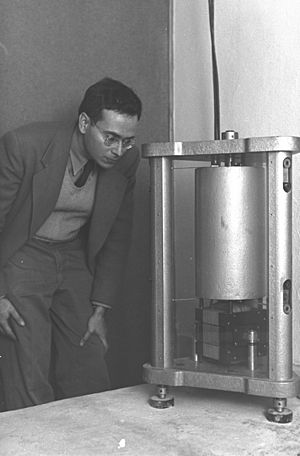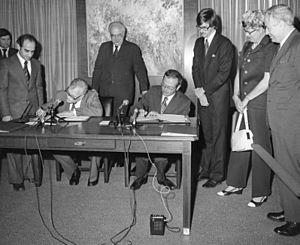Frank Press facts for kids
Quick facts for kids
Frank Press
|
|
|---|---|
 |
|
| 19th President of the National Academy of Sciences | |
| In office 1981–1993 |
|
| Preceded by | Philip Handler |
| Succeeded by | Bruce Alberts |
| 2nd Director of the Office of Science and Technology Policy | |
| In office January 20, 1977 – January 20, 1981 |
|
| President | Jimmy Carter |
| Preceded by | Guyford Stever |
| Succeeded by | Benjamin Huberman (Acting) |
| Personal details | |
| Born | December 4, 1924 New York City, U.S. |
| Died | January 29, 2020 (aged 95) Chapel Hill, North Carolina, U.S. |
| Education | City College of New York (BS) Columbia University (MS, PhD) |
| Awards | William Bowie Medal (1979) Japan Prize (1993) Vannevar Bush Award (1994) AAAS Philip Hauge Abelson Prize (1994) Lomonosov Gold Medal (1997) |
| Scientific career | |
| Fields | Geophysics |
| Institutions | Lamont–Doherty Earth Observatory Caltech Seismological Laboratory Massachusetts Institute of Technology Office of Science and Technology Policy |
| Thesis | Two applications of normal mode sound propagation in the ocean (1949) |
| Doctoral advisor | Doc Ewing |
| Doctoral students | Don L. Anderson Charles Archambeau Ari Ben-Menahem |
Frank Press (born December 4, 1924 – died January 29, 2020) was an American scientist who studied the Earth, especially its physical processes. This field is called geophysics. He was a trusted advisor to four different U.S. presidents. Later, he served two terms as the president of the National Academy of Sciences in the U.S. from 1981 to 1993.
Frank Press also wrote many scientific papers, about 160 of them! He helped write two important textbooks about our planet: Earth and Understanding Earth. He was part of the President's Science Advisory Committee during the time of Presidents John F. Kennedy and Lyndon B. Johnson. President Richard Nixon also chose him to be on the National Science Board. In 1977, President Jimmy Carter made him his Science Advisor and the Director of the Office of Science and Technology Policy. He held these important jobs until 1981.
Contents
Frank Press's Early Life and Work
Frank Press was born in Brooklyn, New York. He earned his first degree from the City College of New York in 1944. He then went on to get his master's and Ph.D. degrees from Columbia University in 1946 and 1949. His teacher there was Maurice Ewing, often called "Doc Ewing."
Frank Press helped start the Lamont Geological Observatory (now called Lamont–Doherty Earth Observatory) in New York. He was one of the first professors there. At first, he studied the ocean, which is called oceanography. He even went on research trips on ships like the RV Vema and RV Atlantis.
In the early 1950s, Frank Press started focusing on seismology, which is the study of earthquakes and how waves travel through the Earth. He helped write an important book about how elastic waves move in different layers of the Earth. In 1957, he was asked to lead the Caltech Seismological Laboratory at Caltech. He stayed in this role until 1965.
During this time, Frank Press designed a special tool called a seismometer. This tool could detect very long waves. He also was the first to detect the Earth's natural vibrations, like a bell ringing, after the huge Great Chilean Earthquake in 1960. This was a new way to use computers to study earthquake recordings. He also helped build a seismograph that was placed on the Moon by the Apollo 11 astronauts to study moonquakes.
Later Career and Achievements
In 1965, Frank Press moved to the MIT. There, he became the head of the Earth and Planetary Sciences department. With help from a generous person named Cecil Howard Green, he brought new energy to the department by hiring many new professors. He worked at MIT until 1976. During this time, he worked with other scientists to use computer programs to predict earthquakes.
In 1976, Frank Press became the Science Advisor to President Jimmy Carter. He also became the director of the Office of Science and Technology Policy. In this role, he wrote a memo to the president about how burning fossil fuels affects the climate. He also played a big part in creating a group that helped scientists in the U.S. and China communicate better. In 1981, he was chosen to be the president of the National Academy of Sciences. He was re-elected in 1987 and served for a total of 12 years.
In 1996, Frank Press helped start a company called WAG (the Washington Advisory Group). This company advised universities and other organizations around the world. WAG was very important in helping to create the King Abdullah University of Science and Technology (KAUST) in Thuwal, Saudi Arabia. Frank Press led the international advisory committee for that university until 2010.
Frank Press received many honors, including 30 honorary degrees. A mountain in Antarctica called Mount Press is named after him. Also, a type of deep-sea worm that eats whale bones, called Osedax frankpressi, is named in his honor.
Personal Life
Frank Press passed away on January 29, 2020, when he was 95 years old. He was the father of another famous scientist, physicist William H. Press.
Awards and Honors
- U.S. National Medal of Science
- Vannevar Bush Award
- Golden Plate Award from the American Academy of Achievement (1962)
- Gold Medal from the Royal Astronomical Society (1971)
- Pupin Medal from Columbia University
- Maurice Ewing Medal from the Society of Exploration Geophysicists (1982)
- Japan Prize from the Emperor of Japan (1993)
- Lomonosov Gold Medal from the Russian Academy of Sciences (1997)
- Ordre national de la Légion d'honneur (France)
- Pick and Gavel Award from the Association of American State Geologists (2007)


